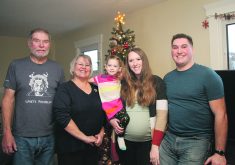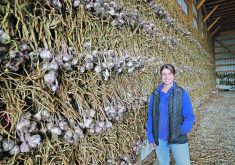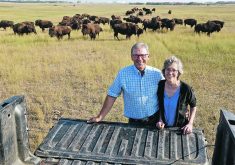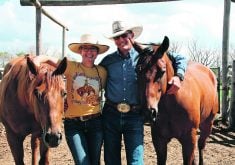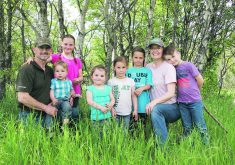On the Farm Liezel and Larry Kennedy started by leasing a flock and then dived right in to the business in a big way
SHAMROCK, Sask. — Not everyone gets a trial run at farming, but Liezel and Larry Kennedy knew before they expanded from 60 to 600 sheep how things would likely go.
They leased a flock that size, on their own farm, from a breeder who wanted to take a year-long sabbatical.
“They had spent years developing genetics,” Liezel explained. “We took it all, the lambs, the records, all their dogs.”
That was the spring of 2015.
“It was a good situation,” said Larry. “Not only was it a profitable lease but it gave us a good lesson.”
The Kennedys and their toddler son, Liam, ranch in the hills between Shamrock and Gravelbourg, Sask., on the family farm where Larry grew up as the youngest child.
He returned to the farm and began taking over in 2008, which is also when he met Liezel. It was a grain and cattle operation then. After a holistic management course in 2009, they began seeding more grass.
Liezel had arrived in Canada in 2007. She grew up in rural South Africa where she had horses but moved to Saskatoon to live with an aunt over fear of crime in her birth country.
Their farming venture started with goats.
Liezel went to buy one or two for milking but came home with seven does and a buck.
The goats were prolific, with a kidding rate of 233 percent, and the herd grew.
But so did myriad problems when the goats purchased at different auctions started to have problems with abortion storms, parasites and disease.
Plus, the goats wanted to be inside and the Kennedys lacked the proper facilities.
The family had always had cattle but when Larry and Liezel took over they sold the cows to pay debts.
Read Also

Nutritious pork packed with vitamins, essential minerals
Recipes for pork
“We were left with the land base and able to buy more,” said Larry.
The operation now includes 21 quarter sections: 14 are grass and seven are rented out to grain farmers. The grass is cross-fenced with electric fence to create grazing paddocks.
In late 2011, they bought 50 ewes through the Saskatchewan Sheep Development Board’s lamb co-op program.
They were advised to buy “something you like looking at” so they chose the clean face and clean legs of the Clun Forest crossed with Cheviot.
They also needed a breed that could do well in a pasture.
“We wanted something medium-sized that could look after themselves on grass,” Liezel said.
They have the usual predator problems, particularly foxes during lambing and coyotes later, and have used llamas and dogs as guardians.
The opportunity to take on the large flock presented itself in the fall of 2014 and that’s when the 120 goats had to go.
“We also sold the last of the cows in the fall of 2014,” Larry said, recalling that for a brief time they had no real chores to do.
That didn’t last long with the first semi-load of their leased flock arriving the following April.
They sold the first lambs in October and bought 300 bred ewes during the next couple of months.
The leased sheep returned home in April 2016 and by December, the Kennedys looked at another flock of 320, which began lambing just days after arriving.
The Kennedys have been lambing on pasture in May but their land lacks good cover in cases of bad weather, and if the grass gets too tall then neither they nor the ewes can find the lambs. They are gradually moving the lambing time to February and March and have begun using lambing jugs under cover.
“By the time the grass is growing, the lambs will be tall enough,” Liezel said.
They are re-using old hog panels inside a Quonset to outfit the lambing barn and have begun work to expand the facility so more ewes can lamb at the same time.
The flock is still predominantly Clun Forest based. They retained 250 ewe lambs last year and have 450 to breed to Bluefaced Leicester this year.
They are using a British model of sheep breeding that involves breeding to a terminal sire to produce better lambs and offspring known as mules. This should also produce better wool, she said.
Health protocols are a critical part of their operation, including vaccinations, Maedi Visna disease prevention and parasite control.
The Kennedys’ goal is to have a closed flock, except for the rams.
This year, the couple installed a machine to feed orphan lambs. They also creep feed lambs on pasture when weaning.
“That really revs up our performance on the lambs,” said Larry.
The couple hopes to increase the number of lambs marketed per ewe, but they aren’t yet aiming for three lambings in two years.
“We’re not quite ready for something like that,” said Liezel.
In addition to their on-farm work, Larry also works as a sheep buyer for SunGold and is the Canadian representative for the Timeless Fence system, a PVC fence post that doesn’t require insulators.








